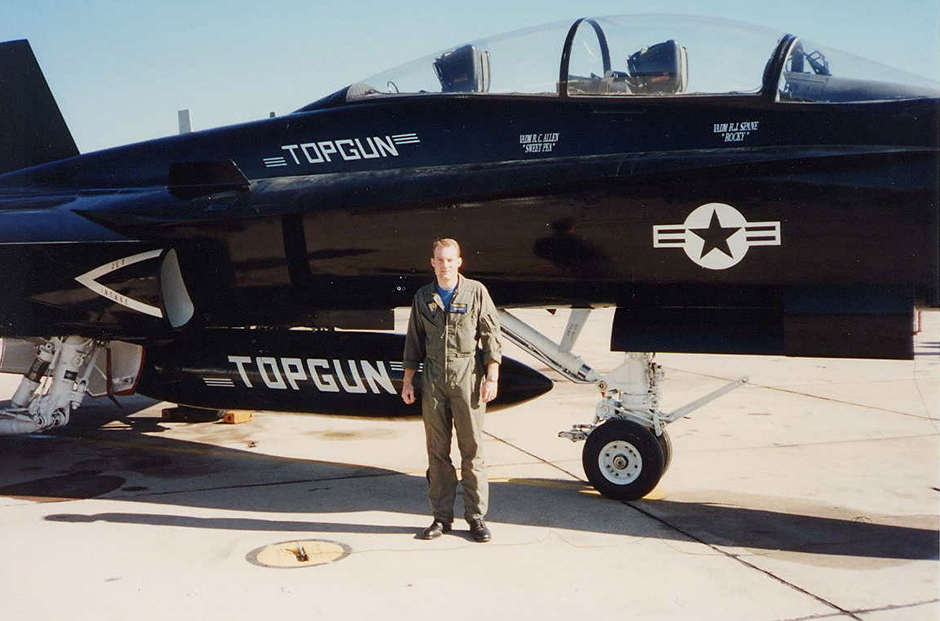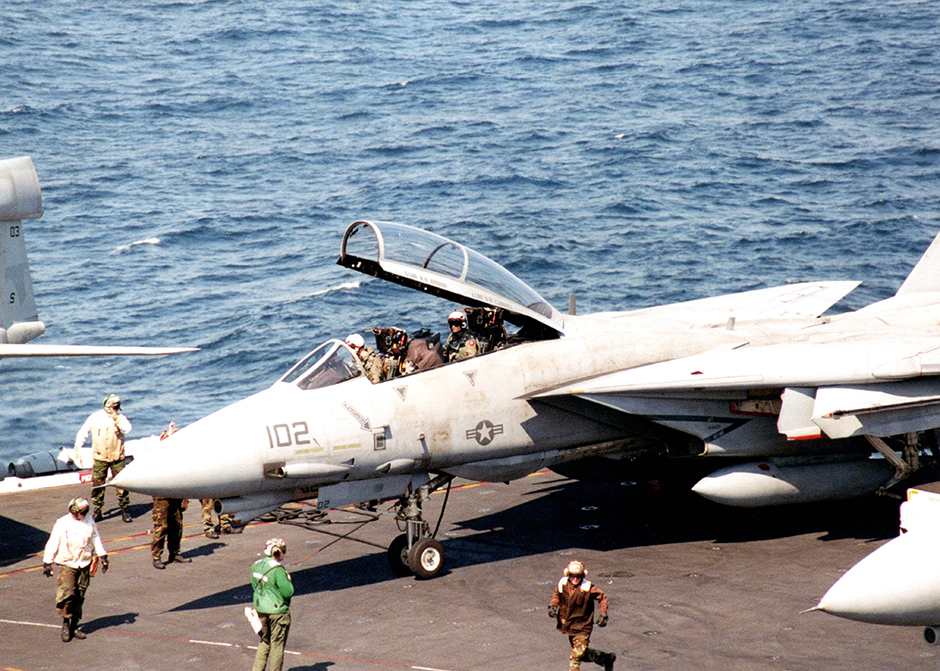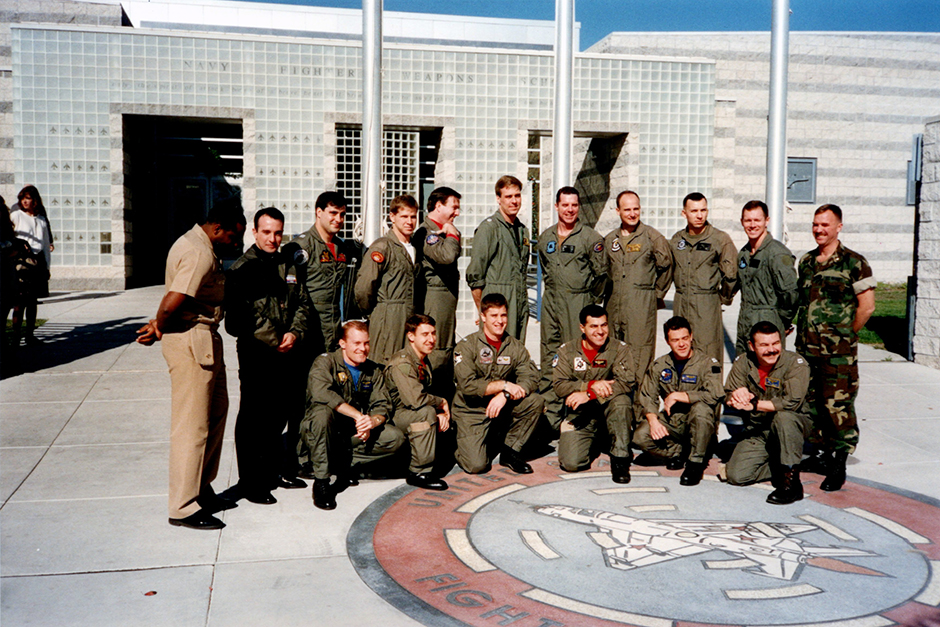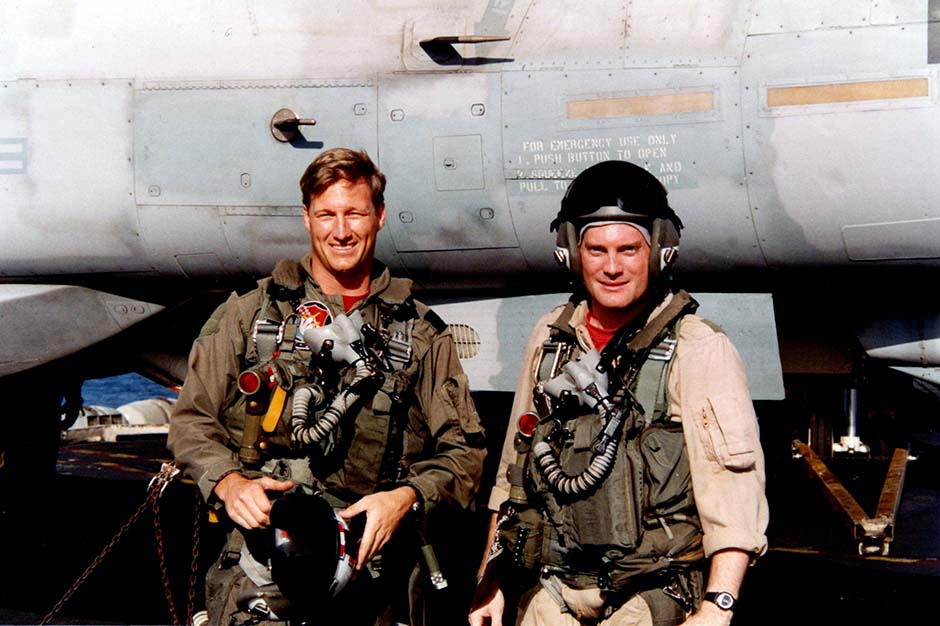UCI’s Top Gun alum
The Naval career of Ron Vaught ’89 parallels the hit movies

He’s flown in F-14 fighter jets at 500 miles per hour, hugging the desert terrain, with sweat dripping down his face as adrenaline pumps through his veins. He served in critical missions in Iraq and Kosovo. And then, the Navy invited him to train hundreds of US Navy aviators.

No, he’s not Tom Cruise’s Top Gun character Maverick. UCI alumnus Ron Vaught ’89, political science, is the real deal.
Vaught was on his path to a naval career well before the 1986 film brought the U.S. Navy Fighter Weapons School into the popular imagination. But seeing the movie while he was an undergraduate at UCI further fueled his fire.
With uncles and distant cousins in the Army, Navy and Marines, Vaught was somewhat familiar with the military growing up. But it was a visit to San Diego’s North Island when he was in sixth grade that changed everything.
“I saw an aircraft carrier with fighter jets on the flight deck,” Vaught recalls. “And that was the moment I knew what I wanted to do.”
By the time he was a teen, Vaught was taking private flying lessons near his home in Palos Verdes, California. At UCI, he majored in political science in the School of Social Sciences, was a staff member for the Student Parent Orientation Program, and was active in a fraternity. By his fourth year, he was studying aviation and aeronautics in his spare time and working out to get into top physical shape before embarking on the greatest challenge of his life: Aviation Officer Candidate School.
I saw an aircraft carrier with fighter jets on the flight deck. And that was the moment I knew what I wanted to do.
Training
Just two weeks after his UCI graduation, Vaught was with 67 other trainees in Pensacola, Florida for AOCS. Three months later, just 16 of them would graduate.
The AOCS boot camp aims to weed out people, and it certainly gave Vaught moments of self-doubt. He swam a mile wearing flight gear and boots, practiced getting out of a tangled parachute in the water, and took rides in the Dilbert Dunker—a device made famous by another movie, An Officer and a Gentleman, in which trainees have to safely maneuver out of an inverted cockpit, sinking in a swimming pool, while wearing all of their flight gear. Vaught describes the experience as a “firehose of information,” much of which was focused on ensuring survival in worst-case scenarios.
“My strongest memories are the most challenging parts of the process,” Vaught says. “It was a great experience that was both a huge challenge and a huge accomplishment.”
Vaught stayed in Pensacola for flight school, and passed each of three increasingly competitive phases of training with flying colors, and was ultimately given the opportunity to choose which aircraft he would specialize in. He chose the F-14 Tomcat, the iconic aircraft featured in the movie Top Gun.
Less than two years after graduating from UCI, Vaught was back in Southern California at Miramar’s F-14 Fleet Replacement Squadron. For 11 months, he learned everything about every system on the aircraft: its radar, navigation, engineering, hydraulics and pneumatics. Vaught, who’s callsign is “Mo,” trained as a radar intercept officer, or RIO, running communication, navigation, and weapons systems from the back cockpit just like Top Gun’s Goose.
“That’s where things really stepped up,” he says. “We practiced tactics for flying the airplane at its best and how to fight with it.”
Vaught soon put that training to use when he flew strike missions in the Persian Gulf, flying from the USS Nimitz with Fighter Squadron 211, nicknamed the “Fighting Checkmates.”

In 1995, Vaught was sent to the U.S. Navy Fighter Weapons School, known as TOPGUN,
for a grueling 13-week course to become a strike fighter tactics instructor. Before
and after every training flight, the crews would spend hours exhaustively and meticulously
detailing every second of the mission, every switch that needed to be flipped.
“When I first started at TOPGUN, I didn’t think I could get through it,” Vaught says. “There were times I would get nervous or think I’m out of my league. But as long as you stayed in the fight, they would see you trying to do your best to learn.”
To graduate from TOPGUN, the crews would take to the air to practice fighting against an unknown enemy, instantaneously deciding how to battle against whatever appeared in the sky ahead of them, whether that was a World War II-era aircraft or a modern fighter jet.
“They were teaching us how to fly at the absolute edge of the envelope to the full capabilities that the airplane had,” Vaught remembers. “Talk about adrenaline rush, you’re soaking wet, your blood is pumping. It was insane.”
But the pressure wasn’t only in the air. Navy strike fighter tactics instructors like Vaught had to learn to teach the Navy way, including strict rules around what to wear (no watches, no ribbons) and how to lecture (no notes). Vaught went through so-called “murder boards” where a highly critical audience of peers would point out weaknesses in his three-and-a-half-hour lecture on third-generation fighter jets.
After surviving the instructor school, Vaught went on to teach hundreds of pilots and RIOs as a designated strike fighter tactics instructor for an F-14 fleet, and then as a training officer for Fighter Squadron 41 (VF-41), nicknamed the “Black Aces.”
The most intense fighting Vaught experienced was while serving on the USS Theodore Roosevelt, flying some of the first U.S. combat missions in Kosovo in 1999.
“It was pretty intense,” he says. Unlike in Iraq, these missions included night vision goggles and laser targeting to assist, and the aviators were being fired at more aggressively from the ground. “The entire sky in front of us lit up like daytime when we hit the petroleum storage facilities.”
After that tour of duty, Vaught helped test new technology on aircraft in Norfolk, Virginia, and then went into the Navy Reserves. During this time, he served in various capacities, including on the team that advised General James Mattis and General Kenneth McKenzie Jr. on developing plans for the U.S. military to withdraw from Afghanistan.
When I first started at TOPGUN, I didn’t think I could get through it. There were times I would get nervous or think I’m out of my league. But as long as you stayed in the fight, they would see you trying to do your best to learn.
Retirement
During his years of service, Vaught says his UCI political science degree helped him understand different nations’ political perspectives.

“It helps to understand different forms of government, how they function, and how that affects their military response to different situations,” Vaught says. “You have to understand the history of countries like Russia to understand why [Vladimir] Putin is going into Crimea, and you have to understand how Saudi Arabia functions to understand why we often appease them.”
In 2017, after 28 years of military service, Vaught posted a message on his personal Facebook account that he was retiring. Friends from college, some of whom he hadn’t heard from in years, flocked to celebrate and honor his career.
“I got up to the podium and saw all these faces of people who I wasn’t expecting,” he says. He reconnected with lifelong friends he made at UCI and, eventually the School of Social Science Alumni Network.
Now, Vaught lives on the Florida coast, trading his F-14 for a Wave Runner, and keeping an eye out for sea rays and sea turtles instead of enemy aircraft. He’s working on a second bachelor’s, in aeronautics, at Embry Riddle Aeronautical University, and is even considering bringing his real-world experience to the college classroom as an instructor.
His advice for UCI students today is to have a long-term plan and then identify steps to achieving that goal. Even if the plan changes along the way, you’re moving forward.
“I knew I wanted to fly F-14s, but there were all these intermediate goals along the way to get there,” he says. “Just focus on what you need to do in the next 6 months to move toward your long-term goal.”
And don’t ever give up on yourself.
“If there’s something you think you can’t do, then you need to rethink your thought process,” Vaught says.
Take it from this TOPGUN graduate: “There’s always a way.”
- Christine Byrd for UCI Social Sciences




